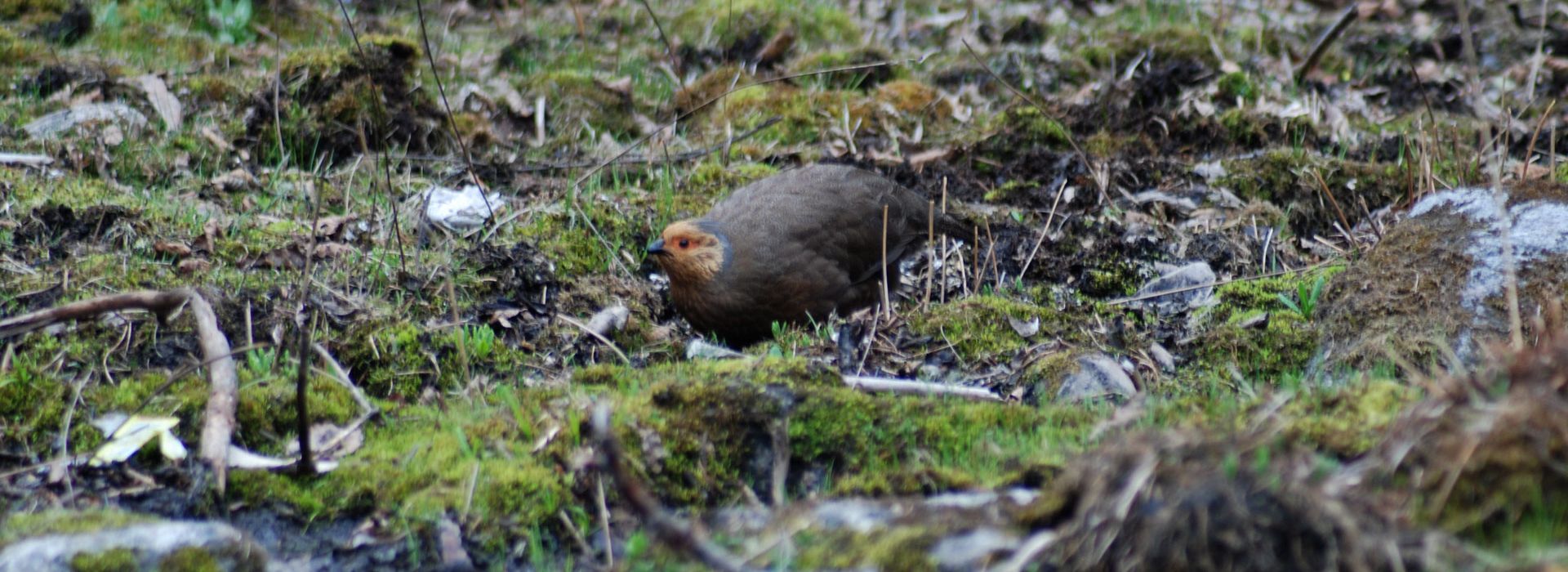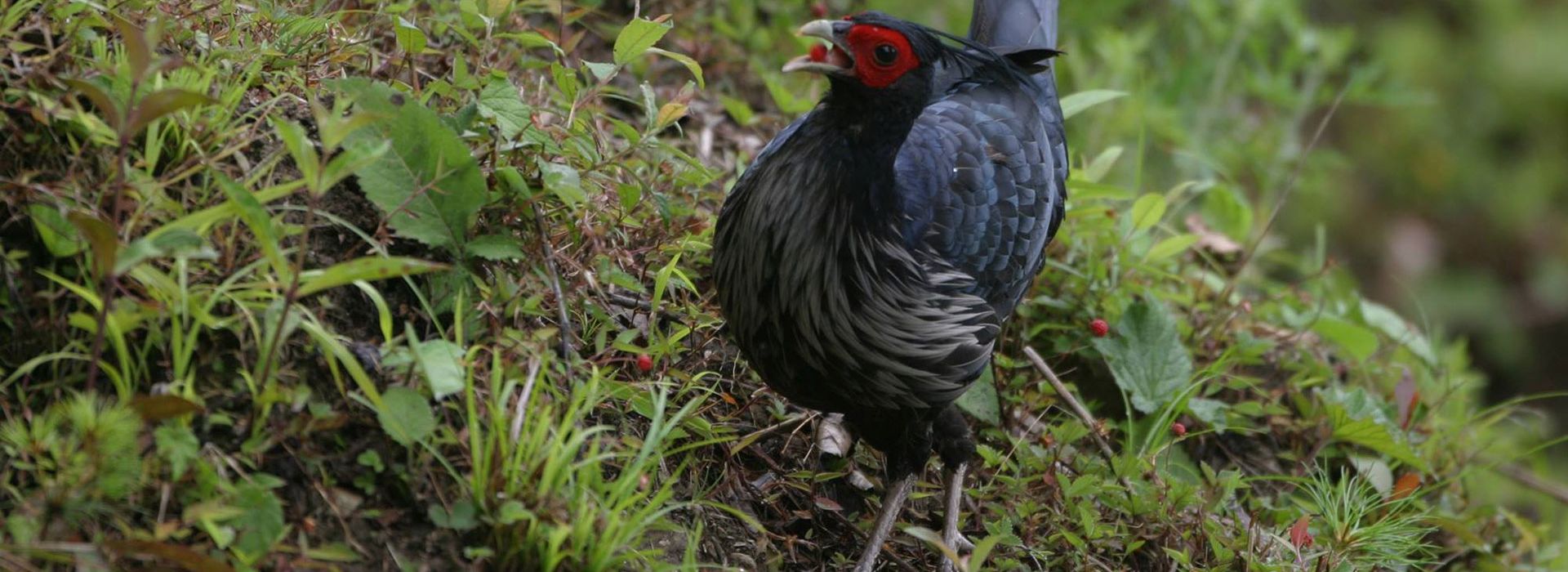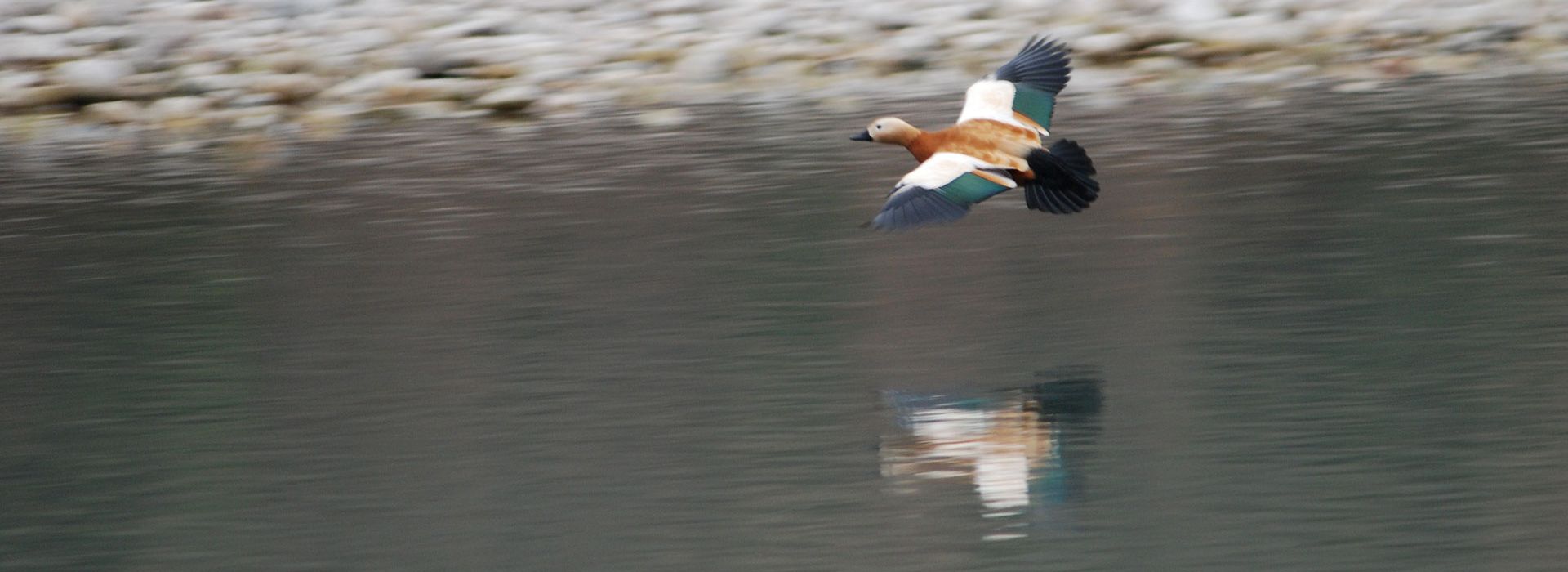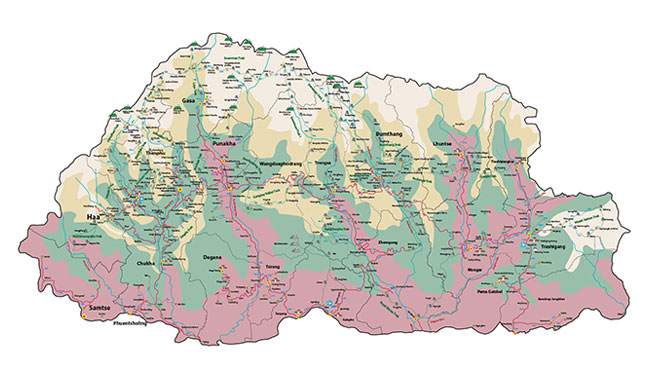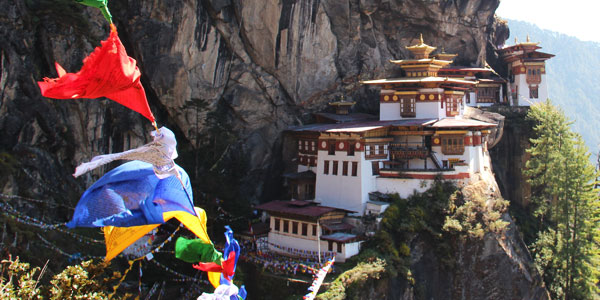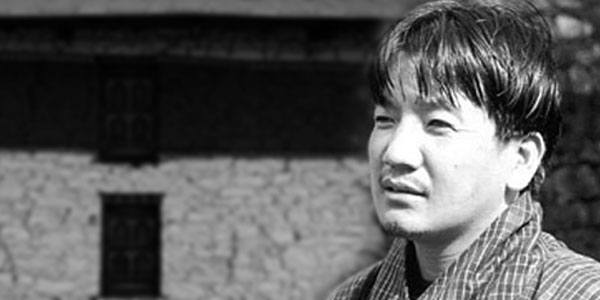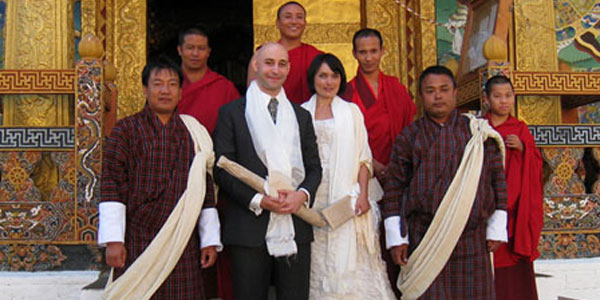Bhutan Birding Tour
10-12 Days
Bhutan has some 800 bird species, rivalling the combined 925 species found in all of North America. Among those, at least 16 species are globally threatened, and 10 fall within the restricted range. The country has even been called the world’s “birding capital”.
Detailed Itinerary
Day 1: Bangkok/Kathmandu/New Delhi-Paro (2,250m)
We begin our tour from Paro in western Bhutan. We explore the valley which is a delight to see as it is filled with cultural and historical monuments. Our particular interest will be to spot Ibisbill which inhabits sandbanks of the rivers and the Black-tailed Crake. Other birds to look for include Brown Dipper, Plumbeous and White-capped Water-Redstarts, Siberian Stonechat, Grey Bushchat, Blue Whistling Thrush, Himalayan Wagtail, River Lapwing, Oriental Turtle Dove, Eurasian Hoopoe, Himalayan Black Bulbul, Grey-backed Shrike, Red-billed Chough, Large-billed Crow, Green-backed Tit, Russet Sparrow, Green Sandpiper, Rosy Pipit, Rufous-breasted Accentor, Black-throated Thrush and Hodgson’s Redstart.
Day 2: Paro-Chelela-Thimphu (2,320m)
We start early to the scenic Chelela mountain pass (3,780 m). This place is excellent to spot Himalayan Monal, considered to be among world’s 10 most beautiful birds. We will also sour the area for Blood Pheasant and Kalij Pheasant. Other species found include: Long-tailed Thrush, White-collared Blackbird, Mrs Gould’s Sunbird, Olive-backed Pipit, the huge Collared Grosbeak, White-winged Grosbeak, Himalayan White-browed and Dark-rumped Rosefinches, Eurasian Sparrowhawk, Grey Nightjar, Yellow-billed Blue Magpie, Spotted (or Eurasian) Nutcracker, Long-tailed Minivet, Coal, Grey-crested and Rufous-fronted Tits, Black-faced Laughingthrush, White-browed Fulvetta, Rufous-vented Yuhina, Rufous-gorgeted Flycatcher, Buff-barred Warbler, Himalayan Red-flanked Bluetail (split from Northern), Blue-fronted Redstart. Towards, we will drive to Bhutan’s capital, Thimphu (2,350m) and camp near Dochu La for the night.
Day 3: Thimphu-Dochula-Punakha (1,350m)
Dochula (3,100m) is the most scenic mountain pass in Bhutan, surrounded by forests of hemlock, fir, rhododendron and evergreen oak. With the mighty peaks of the eastern Himalayas as the backdrop, we begin to look for White-throated, Striated and Chestnut-crowned Laughingthrushes, Darjeeling Woodpecker, Rufous Sibia, Hoary-throated Barwing, Stripe-throated Yuhina, Rufous-winged Fulvettas, Lemon-rumped and Ashy-throated Warblers, Whistler’s Warbler, Yellow-browed Tit, Rusty-flanked Treecreeper, Green-tailed Sunbird, Common Crossbill, Dark-breasted Rosefinch and Red-headed Bullfinch. We may even spot the beautiful Fire-tailed Myzornis here. Towards the evening we descend to Punakha (1,350m).
Day 4: Punakha (1,350m)
This sub-tropical valley has its crown jewel, the splendid Punakha Dzong, the ancient capital flanked by male and female rivers, Pho Chhu and Mo Chhu. We hike up the Mo Chhu, and along a wide stretch of forests along the river bank and its tributaries, we look for Crested Kingfisher, Great Cormorant, and Slaty-backed Forktail. In particular we will be keen to see, among numerous other species, Yellow-vented Warbler, Spotted Wren-Babbler and, if lucky be on our side, the extremely rare White-bellied Heron, and Pallas’s Fish Eagle. Other species found in this area include Grey-headed Woodpecker, Greater and Lesser Yellownapes, Maroon Oriole, Ashy and Hair-crested Drongos, Common Myna, Grey Treepie, Black-winged Cuckoo-Shrike, Mountain Bulbul, Ultramarine, Verditer and Grey-headed Flycatchers, Small Niltava, Slaty-bellied Tesia, Blyth’s Leaf, Green-crowned and Grey-hooded Warblers, Black-throated Tit, Chestnut-bellied Nuthatch, Fire-breasted Flowerpecker, Crested Serpent Eagle, Spotted Dove, Himalayan Cuckoo, Himalayan Swiftlet, House Swift, White-throated Kingfisher, Great and Golden-throated Barbets, and Black-throated Sunbird. We will also look for babblers including Rufous-capped Babbler, Rufous-chinned Laughingthrush, Red-tailed and Blue-winged Minlas, Whiskered Yuhina and Nepal Fulvetta.
Day 5: Punakha-Phojikha (3,000m)
Today, we head into the interior, from Wangdue all the way to Phobjikha valley. The route is thickly forested and we will be birding along this way amongst ever-changing vegetation from the sub-tropics to the temperate to the alpine. We will look out for the elusive Yellow-rumped Honeyguide among hives of Rock Bees. Other birds usually found in this stretch include Grey-sided Bush Warbler, Wedge-tailed Green Pigeon, Fork-tailed Swift, Chestnut-bellied and Blue-capped Rock Thrushes, Yellow-bellied Fantail, Fire-tailed Sunbird Himalayan Griffon, Lammergeier, Indian Blue Robin, and Hume’s Bush Warbler.
Day 6: Phojikha-Bumthang (2,600m)
We continue eastward, along what is locally termed as “lateral highway,” crossing two mountain passes, Pele La (3,300m) and Yotong La (3,400m) We will try to spot Himalayan Wood Owl, the rare Wood Snipe, and high altitude species such as Alpine Accentor, White-browed Bush Robin, Great and Brown Parrotbills, and Fulvous Parrotbill. Other new birds along this stretch may include Rufous-bellied Woodpecker, Spotted Forktail, and Speckled Woodpigeon. We finally reach the wide pine-forested Bumthang valley, considered one of the most beautiful in Bhutan.
Day 7: Bumthang-Yongkala (1,855m)
Our main birding area today is in and around the thick hemlock and rhododendron forests of Thrumshing La Pass (3,750m). The pass is often visited by high-altitude species like the Goldcrest, Golden Bush Robin, Rufous-vented Tit, Himalayan Beautiful Rosefinch Blood Pheasant, Snow Pigeon, and Spotted Laughingthrush. From the pass, we descend, through hairpin bends, to Lingmethang road. This stretch of road is an ornithologist’s delight so much so that it has often been dubbed as the “birding capital of the world”. The icing on the cake is that only a handful has been here in the past.
Days 8-11: Lingmethang Road (650-1855m)
We spend five nights along this road. The fact that this area is so rich in birds is attributable to its incredibly wide climatic and forest variations. Lingmethang is just 650m above the sea level. But, in barely 80 kilometres or so, one gains a height of 3,750m. This region harbors some of the most sought-after Himalayan bird species, the list too long to be mentioned here in its entirety, and the variety so diverse. The list includes Ward’s Trogon, Rufous-necked Hornbill, Satyr Tragopan which is described as the “poster bird of the Himalayas”, Blue-fronted Robin, Yellow-throated Fulvetta and Grey-cheeked Warbler, Greater Rufous-headed Parrotbill, Rusty-fronted Barwing, White-naped Yuhinas, Rufous-throated Wren-Babbler, Bar-winged Wren-Babbler, Sikkim Wedge-billed Babbler, Coral-billed Scimitar-Babbler, Slender-billed Scimitar-Babbler, and Broad-billed Warbler.
Others on the list include: Yellow-bellied Fantail, Chestnut-headed and Grey-bellied Tesias, Brownish-flanked Bush Warbler, Hill Prinia, Mountain Tailorbird, Large-billed Leaf, Chestnut-crowned and Black-faced Warblers, White-browed and Lesser Shortwings, White-tailed Robin, Grey-winged Blackbird, Yellow-cheeked Tit, White-tailed Nuthatch, Brown-throated Treecreeper, Oriental White-eye, Lesser Racket-tailed Drongo, Crested Goshawk, Mountain Hawk Eagle, Large Hawk-Cuckoo, Common, Lesser and Drongo Cuckoos, the dazzling Asian Emerald Cuckoo, Asian Barred Owlet, Red-headed Trogon, Blue-bearded Bee-eater, Crimson-breasted and Bay Woodpeckers, Oriental Skylark, Nepal House Martin, Grey-chinned Minivet, Striated Bulbul, Streak-breasted and Rusty-cheeked Scimitar Babblers, Scaly-breasted and Pygmy Wren-Babblers, Golden Babbler, Black-throated Parrotbill, White-crested, Grey-sided and Scaly Laughingthrushes, the near-endemic Bhutan Laughingthrush (split from Streaked), Red-billed Leiothrix, Cutia, White-browed and Black-eared Shrike-Babblers, Chestnut-tailed Minla, Black-chinned Yuhina, the stunning little Golden-breasted Fulvetta, Dark-sided, Little Pied, Blue-throated, Pygmy Blue and Pale Blue Flycatchers, the shy Sapphire Flycatcher, the secretive White-gorgeted Flycatcher, Large and Rufous-bellied Niltavas, Yellow-breasted Greenfinch and Crimson-browed Finch.
Day 12: Lingmethang-Bumthang (2,600m)
We retrace our journey to Bumthang.
Day 13: Bumthang-Trongsa (2,100m)-Tingtibhi (600m)
We first drive to Trongsa (or Tongsa) and then onward, taking southerly direction, to Zhemgang and finally to Tingtibi. From our campsite at Tingtibhi, we will be looking for more birds for the next three days.
Days 14-15: Tingtibhi (600m)
The Tingtibhi and the adjoining areas also offer some of the best birding sites in Bhutan. Our principal chase will be Beautiful Nuthatch, which os rare and localized. Other species found in this area are Scarlet Minivet, Red-vented, White-throated and Ashy Bulbuls, Bronzed Drongo, Long-tailed Shrike, Oriental Magpie Robin, Blue Rock Thrush, Striated Prinia, Rufous-faced Warbler, Yellow-bellied Warbler, the superb Rufous-necked and Blue-winged Laughingthrushes, Lesser Necklaced Laughingthrush, Crimson Liocichla, White-browed Scimitar Babbler, Grey-throated Babbler, Silver-eared Mesia, Striated Yuhina, Long-tailed Sibia, Sultan Tit, Streaked Spiderhunter, Crested Bunting, Oriental Honey Buzzard, Black Eagle, Emerald Dove, Bar-tailed Cuckoo-Dove, Pin-tailed Green Pigeon, Whistling Hawk-Cuckoo, Indian and Violet Cuckoos, White-throated Needletail, Blue-throated Barbet, White-browed Piculet, Rufous Woodpecker, Long-tailed Broadbill, Orange-bellied Leafbird, Common Green Magpie, and Rufous-necked Hornbill. This place is also frequented by the rare and endangered Golden Langur monkey.
Day 16: Tingtibhi-Camp Enroute to Gelephu
We drive further downhill and camp at a roadside clearing on the way to Gelephu, the town which shares border with the Indian state of Assam. This stretch is relatively unexplored by birding enthusiasts and as we make our way down, we will make several stops to look for, among other species, Scarlet Finch and Brown Bullfinch.
Day 17: Camp-Gelephu (300m)
We stay overnight at Gelephu. Here, in this warm and humid plain, we will look for lower foothill forest birds such as Dark-rumped Swift, Thick-billed Green Pigeon, Mountain Imperial Pigeon, Plaintive and Banded Bay Cuckoos, Green-billed Malkoha, Dollarbird, Wreathed, Great and Oriental Pied Hornbills, Blue-eared Barbet, Speckled Piculet, Grey-capped Woodpecker, Large Woodshrike, Common Iora, Golden-fronted Leafbird, Asian Fairy-Bluebird, Black-crested and Red-whiskered Bulbuls, Striped Tit-Babbler, Black-naped Monarch, Rufescent Prinia, Common Tailorbird, White-rumped Shama, Greater Racket-tailed Drongo, Common Hill Myna, Black-backed Forktail and Crimson Sunbird.
Day 18: Gelephu-Guwahati (Assam, India)
Today, we cross into India and travel to Guwahati, the state capital of Assam which lies on the banks of the mighty Brahmaputra River. Enroute, we will be able to see many species of the plains such as Indian Pond Heron, Eastern Cattle, Great, Intermediate and Little Egrets, Asian Openbill, Greater Adjutant, Lesser Adjutant, Little Cormorant, Lesser Whistling Duck, Black and Black-eared Kites, White-rumped Vulture, the endangered Slender-billed Vulture, Grey-headed Swamphen, Bronze-winged Jacana, Red-wattled Lapwing, Rose-ringed Parakeet, Asian Palm Swift, Blue-tailed Bee-eater, Indian Roller, Richard’s Pipit, Zitting Cisticola, Striated Grassbird, Black-hooded Oriole, Black Drongo, Ashy Wood-Swallow, Asian Pied Starling, Jungle Myna, House Crow and Eastern Jungle Crow.
We reach Guwahati airport towards late afternoon.
Tour Facts
- Duration: Ten to Twelve Days
- Season: Throughout year
- Tour Entry: Paro, Bhutan. Exit: Guwahati, India
- Places of Visit: Paro, Thimphu, Punakha & Wangdue valleys, Phojikha, Trongsa & Bumthang.
- Area Coverage: 11 districts, 22 birding areas
- Group Size: 1 pax & Above
Package Includes
3-star plus hotels, three meals, SUV/mini bus/coaster, guides, entry fees, mineral water, cultural program (in groups of 10 or more people), and taxes.
Package Excludes
Air tickets, travel insurance, drinks, visa fee & laundry.
